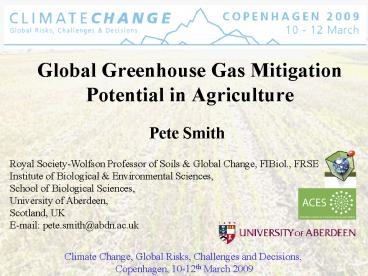Global Greenhouse Gas Mitigation Potential in Agriculture - PowerPoint PPT Presentation
1 / 20
Title:
Global Greenhouse Gas Mitigation Potential in Agriculture
Description:
Royal Society-Wolfson Professor of Soils & Global Change, FIBiol., FRSE ... Daniel Martino, Zucong Cai, Daniel Gwary, Henry Janzen, Pushpam Kumar, Bruce ... – PowerPoint PPT presentation
Number of Views:91
Avg rating:3.0/5.0
Title: Global Greenhouse Gas Mitigation Potential in Agriculture
1
Global Greenhouse Gas Mitigation Potential in
Agriculture
- Pete Smith
Royal Society-Wolfson Professor of Soils Global
Change, FIBiol., FRSE Institute of Biological
Environmental Sciences, School of Biological
Sciences, University of Aberdeen, Scotland,
UK E-mail pete.smith_at_abdn.ac.uk
Climate Change, Global Risks, Challenges and
Decisions, Copenhagen, 10-12th March 2009
2
Co-authors of the work
- Daniel Martino, Zucong Cai, Daniel Gwary, Henry
Janzen, Pushpam Kumar, Bruce McCarl, Stephen
Ogle, Frank OMara, Charles Rice, Steve Rose, Bob
Scholes, Oleg Sirotenko, Mark Howden, Tim
McAllister, Genxing Pan, Vladimir Romanenkov, Uwe
Schneider, Sirintornthep Towprayoon Martin
Wattenbach
3
Method
- Database of over 200 experiments to derive
per-area / per-animal mitigation efficiencies for
gt60 agricultural mitigation options, for four
climate zones for CO2, CH4 and N2O - Mean estimates and low and high 95 CI values
derived from mixed effects modelling - Applied to appropriate agricultural (crop, grass,
livestock) areas / numbers in each climate zone
in each region
Smith et al. (2007, 2008)
4
Ogle et al. (2003)
5
Per-area / per-animal mitigation potential
For 14 practices, for 4 climate zones, for CO2,
N2O CH4, estimates for mean and /- 95CI
Smith et al. (2008)
6
Soil C sequestration rates for cool dry climate
Data from Smith et al. (2008)
7
Soil C sequestration rates in different climates
Cool
Warm
Dry
Moist
Data from Smith et al. (2008)
8
IPCC AR4 Agricultural GHG Mitigation
FAO AEZ Database (e.g. showing land cover)
9
IPCC AR4 Agricultural GHG Mitigation
FAO AEZ Database (e.g. showing thermal climate)
10
IPCC AR4 Agricultural GHG Mitigation
FAO AEZ Database (e.g. showing production
constraints)
11
Global mitigation potential in agriculture
Smith et al. (2008)
12
High and low estimates of the mitigation
potential in each region
Smith et al. (2007)
13
Effect of C price on implementation
Smith et al. (2007)
14
Global mitigation potential in agriculture (Mt
CO2-eq. yr-1)
Smith et al. (2007a)
15
Additional mitigation from agriculture
- Feed-stocks for bio-energy (residues, dung and
dedicated energy crops). - The economic mitigation potential for
agricultural bio-energy in 2030 is estimated to
be 70-1260, 560-2320 and 2720 Mt CO2-eq. yr-1 at
prices up to 20, 50 and above 100 USD t
CO2-eq.-1, respectively (5-90 of all other
measures together). - Additional mitigation of 770 Mt CO2-eq. yr-1
could be achieved by 2030 by improved energy
efficiency in agriculture
Smith et al. (2007a)
16
How important is this mitigation potential?
- Even at 100 USD t CO2-eq.-1, mitigation potential
is 3100-3300 Mt CO2-eq. yr-1 - This is equivalent to less than 1000 Mt C yr-1 or
lt1 Pg per year - Atmospheric CO2-C is increasing at a rate of 3.2
Pg C yr-1 so soil C sequestration can mitigate
about 30 of this increase and less than 15 of
annual 1990s fossil fuel C emissions - So is this significant?
17
What are our targets?
- The EU has an 8 GHG emission reduction target
under the Kyoto Protocol (compared to 1990) - Longer term target to avoid dangerous climate
change 2ºC temperature increase) 80
reduction in GHG emissions by 2050 (generally
accepted need already in law in UK Scotland) - So mitigation potential of 15 of total GHG
emissions is above Kyoto target (in only one
sector), and forms a significant chunk of the 80
GHG emission reduction target for 2050 - Answer Yes it is very significant
18
Global economic mitigation potential for
different sectors at different carbon prices
IPCC WGIII (2007)
19
Conclusions
- Agriculture has a significant role to play in
climate mitigation - Agriculture is cost competitive with mitigation
options in other sectors - Bio-energy crops and improved energy efficiency
in agriculture can contribute to further climate
mitigation, but the savings are usually counted
in other sectors - Agricultural mitigation should be part of a
portfolio of mitigation measures to reduce
emissions / increase sinks whilst new, low carbon
energy technologies are developed.
20
Thank you for your attention































